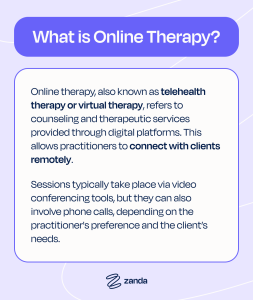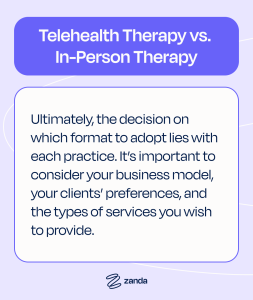In recent years, telehealth therapy has emerged as an alternative to traditional in-person therapy. In fact, the data shows that the virtual therapy market is expected to grow by more than $31 billion by 2028.
Telehealth therapy (or online therapy) allows therapists to provide services via digital platforms, while in-person therapy refers to face-to-face sessions in physical locations.
In this article, we’ll discuss some pros and cons of each approach to help you decide which option works best for your practice and your clients.
What is Online Therapy?
Online therapy, also known as telehealth therapy or virtual therapy, refers to counseling and therapeutic services provided through digital platforms. This allows practitioners to connect with clients remotely.
Sessions typically take place via video conferencing tools, but they can also involve phone calls, depending on the practitioner’s preference and the client’s needs.
A variety of technologies can be used to deliver online therapy, including dedicated telehealth software. Although many virtual meeting platforms are convenient, it’s essential to ensure that your chosen platform provides a secure, HIPAA-compliant environment to help ensure client confidentiality and safety.
Pros of Online Therapy
Online therapy offers several key advantages for both practitioners and clients.
Here are some of the major benefits:
- Convenience and Flexibility: Both practitioners and clients can enjoy the convenience of scheduling sessions that fit their busy lives. Clients can join appointments from anywhere, and practitioners can set their hours without the constraints of a physical office.
- Accessibility: Telehealth therapy is especially valuable for clients in rural or remote areas, as well as those with mobility issues, who might otherwise struggle to access in-person care. It breaks down geographic barriers and brings therapy right to the client’s home.
- Cost-Effectiveness:
- For practitioners, online therapy can reduce overhead costs by eliminating the need for an office outside of the home, including utilities and maintenance for a separate office space.
- For clients, it reduces travel costs and time spent commuting to and from appointments. Some practices also offer lower rates for telehealth sessions, making mental health care more affordable.
- Reduced Stigma: Online therapy can be a more discreet option for clients worried about the stigma of seeking mental health help. It allows them to avoid the potential of running into acquaintances in waiting rooms or on the way to appointments, particularly in smaller communities where privacy is harder to maintain.
- Reduces Booking Cancellations: Online therapy removes barriers that may prevent a client from attending an in-person appointment. For example: if the client’s vehicle breaks down or their child is unwell, they can still attend an online appointment. Alternatively, if a client, who usually attends in person, is unwell or running late, they may be offered an online appointment to avoid a cancellation and loss of income.
Cons of Online Therapy
While online therapy offers advantages, it does come with certain challenges:
- Lack of Physical Presence and Connection: Without being in the same room, some therapists and clients may feel a weaker sense of connection. Nonverbal cues, such as body language, may also be harder to notice or interpret.
- Technical Difficulties: Glitches such as poor internet connections or audio issues can disrupt sessions. Additionally, some clients, particularly those who aren’t as tech-savvy, may struggle with using the technology required for telehealth.
- Privacy Concerns: Finding a quiet, private space for therapy can be a challenge for some clients, especially those living in shared or busy households. There may also be safety factors to consider, such as in situations where there is family violence. Background noise and interruptions may cause discomfort or make it difficult to focus during sessions.
- Not Suitable for Every Client or Condition: Online therapy isn’t always the right fit for everyone. Certain conditions, such as severe mental health issues or complex therapeutic needs, may require the in-person support and structure that only face-to-face therapy can provide.
What is In-Person Therapy?
In-person therapy, also known as traditional face-to-face therapy, allows clients to meet with their therapist in a physical setting, such as a clinic, office, or counseling center.
These sessions provide a private, controlled environment where the therapist and client can engage directly.
Pros of In-Person Therapy
In-person therapy offers several distinct advantages that make it a preferred choice for many practitioners and clients:
- Physical Presence and Connection: Face-to-face sessions can foster a stronger sense of connection between therapist and client, which can help to build trust and rapport.
- Enhanced Observation of Nonverbal Cues: In-person sessions allow therapists to pick up on subtle nonverbal cues, such as body language, facial expressions, and even shifts in posture, which may not be as visible during online sessions. These insights can provide valuable context for understanding a client’s emotional state and can be helpful for clients with attention-deficit challenges.
- Ideal for In-Depth Therapeutic Interventions: Certain therapeutic approaches, such as trauma-focused therapy or therapies involving physical activities, may be more effective in person. The structured, safe environment of a therapist’s office is better suited for these intensive interventions.
- Separation from Everyday Life: For many clients, physically going to a therapist’s office provides a sense of separation from their daily environment. This neutral space can make it easier to open up about sensitive or difficult topics without the distractions or emotional baggage of home, creating a safe, dedicated space for reflection and healing.
Cons of In-Person Therapy
Despite its benefits, in-person therapy also has some drawbacks worth noting:
- Limited Accessibility: In-person therapy can be challenging for clients living in remote areas or for those with mobility limitations. Parents with young children may also find it challenging to access in-person therapy due to frequent childhood illnesses or not having access to childcare. Travel to an office can pose significant barriers, preventing some individuals from receiving the care they need.
- Higher Costs: A physical office comes with expenses, including rent, utilities, and maintenance, which can lead to higher fees for clients. Additionally, clients may incur transportation costs, making in-person therapy less affordable for some.
- Discomfort or Anxiety Related to Traveling: For some clients, the process of traveling to a therapy appointment can cause anxiety or discomfort. This may be especially true for individuals who struggle with transportation issues, social anxiety, or other related concerns.
- Increased Risk of Exposure to Illness: In-person therapy carries a greater risk of exposure to illnesses, especially during cold and flu seasons or in the wake of pandemics. This concern can deter some clients from seeking necessary support, particularly those with underlying health conditions.
Is Online Therapy or In-Person Therapy Right for Your Practice?
This is a decision that you have to make for your practice.
Online therapy offers convenience, accessibility, and cost-effectiveness, which makes it an attractive option for many clients. However, it may lack the physical presence and connection that some individuals find crucial, and technical difficulties can pose challenges.
On the other hand, in-person therapy provides the benefits of direct interaction, enhanced observation of nonverbal cues, and a structured environment for deeper therapeutic interventions. Yet, it can be less accessible for those in remote areas, may incur higher costs, and could lead to discomfort or anxiety related to travel.
Some practices find that a hybrid approach combining both online and in-person therapy works best, as they can cater to a broader range of client needs. This flexibility can enhance accessibility and provide opportunities for face-to-face connection when needed.
Ultimately, the decision on which format to adopt lies with each practice. It’s important to consider your business model, your clients’ preferences, and the types of services you wish to provide.
No matter which approach you choose, Zanda has the tools you need to run and grow your allied health practice.
Ready to see how Zanda makes practice management easy? Sign up for a 14-day Free Trial today, no credit card required.







